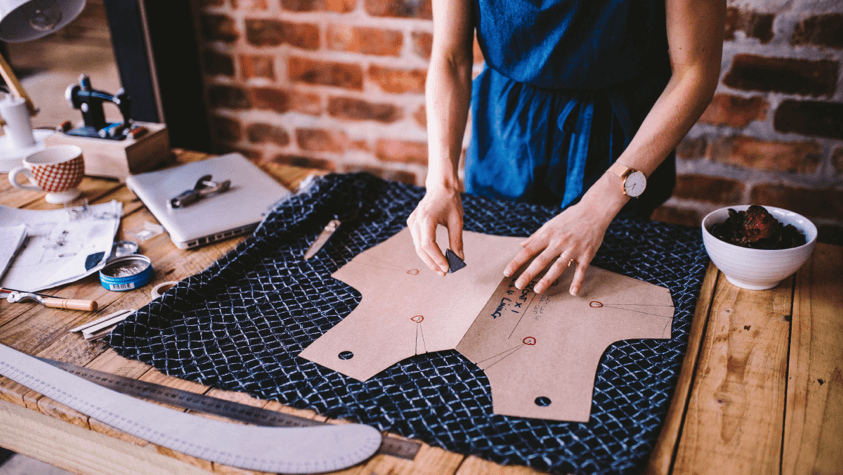By TACP Staff on July 23, 2021

Professional pattern makers are employed by apparel companies and work closely with design teams. Depending on the employer, pattern makers may be required to execute the design from the 1st pattern through production. Comprehension of fabric properties, the ability to execute corrections, manage fittings, and knowledge of Photoshop and Illustrator are some of the qualifications sought after by the industry.
Nearly every garment that is made today is created by piecing pieces of fabric together. These individual pieces of fabric are usually cut out with the help of a pattern.
Apparel patterns, or garment patterns, are shapes that are cut out before a garment is made, and one pattern can often be used to make several garments. Patterns can be cut out of several different materials, including fabric and plastic, but a thin paper known as pattern paper is typically the most common type of material.
The purpose of a pattern is simple. When creating several of the same type of garment, the pieces used to make the clothing should be uniform size and shape from one garment to the next in order to prevent unusually shaped or sized garments. Tracing around or cutting around pattern pieces for each of the different sections of a garment helps ensure this uniformity.
A patternmaking career generally involves working deep in the fashion industry. They may work to design and create patterns for unique pieces of clothing for mass production, for instance, or they may work closely with designers in order to create custom patterns.
Before creating a pattern, a patternmaker must first have a good idea or image of what type of pattern needs to be made. In some cases, patternmakers must come up with these design ideas and sketches themselves. On the other hand, patternmakers might also be required to look at a sketch or picture of a certain garment and create a pattern from that.
In order to create a good pattern, a patternmaker must first decide what size the garment will be. This can often be done by basing a new pattern on an existing pattern that is available in several different sizes.
Some patternmakers are spatial and math whizzes, however, and they may be able to create a pattern simply by getting the measurements of people’s bodies. These measurements are then used to create a pattern to make a perfectly sized garment.
Draping is another relatively common method of creating a garment pattern. To use this method, cloth is draped over a dress form or mannequin and pinned in place. The fabric is then marked where the seams would be, and it is then laid out onto pattern paper. The marks made on the draped fabric can then be traced onto the pattern paper to create pattern pieces.
Conceptualizing, measuring, drawing, and cutting out the pieces of a pattern, however, is not usually the end of a patternmaker’s job. The majority of patternmakers, for instance, will also usually help decide which type and color of fabric should be used to make the garment as well.
Once a pattern is complete, the majority of patternmakers will then sew together a test garment. Making this garment helps ensure that a pattern is useful and accurate. In some cases, a garment may not go together correctly, and a patternmaker may need to adjust the pieces of the pattern.
A degree in this area can catapult you into an exciting and fast-paced career in the garment and fashion industry.
Related: Fashion Design Schools
Professional patternmakers can often find steady work with large clothing and accessory manufacturers. Some pattern makers may even make a decent living creating sewing patterns for do-it-yourselfers.
Patternmaking careers can also sometimes go hand in hand with fashion design careers. Some patternmakers work with fashion designers, for instance, creating patterns used to make some of the fashions seen on the major runways. Also, a number of patternmakers are also successful fashion designers, and vice versa.
Salaries for Pattern Making are variable based on experience, level of education, type of employer and where you’re located. According to BLS, the median salary in 2018 was $49,180. The lowest 10 percent earned less than $23,360, and the highest 10 percent earned just short of $87,820.
According to the Bureau of Labor Statistics, the number of patternmaking careers, as well as the average salary for patternmakers, is projected to decline -13% from 2018 to 2028. This is mostly due to the fact that garment manufacturers have been able to find extremely inexpensive laborers overseas. Although you may not be able to strike it rich as a patternmaker, you will most likely be able to make a decent wage with this type of career.
Due to the extensive use of measurements and geometric shapes, an aspiring patternmaker should be a skilled mathematician. Drawing and fashion design skills are also helpful, as are sewing skills. Individuals interested in pursuing a career in patternmaking will usually need to attend an art institute or fashion design school in order to earn a degree in patternmaking or fashion design. Some traditional universities may also offer the necessary courses needed to pursue a career in patternmaking. Students interested in this area will usually need to take classes in drawing, CAD, anatomy, textile design, and math, as well as fashion design.
Consider these related careers in Fashion.

The Art Career Project is a trusted resource for emerging and professional artists.